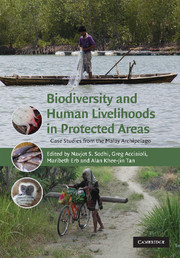Book contents
- Frontmatter
- Contents
- List of contributors
- Acknowledgements
- 1 General introduction
- Part I Conservation needs and priorities
- 2 Introduction to Part I
- 3 Delineating Key Biodiversity Areas as targets for protecting areas
- 4 A Master Plan for Wildlife in Sarawak: preparation, implementation and implications for conservation
- 5 Indonesia's protected areas need more protection: suggestions from island examples
- 6 Birds, local people and protected areas in Sulawesi, Indonesia
- 7 Importance of protected areas for butterfly conservation in a tropical urban landscape
- 8 Biodiversity conservation and indigenous peoples in Indonesia: the Krui people in southern Sumatra as a case study
- 9 Involving resource users in the regulation of access to resources for the protection of ecosystem services provided by protected areas in Indonesia
- 10 Conclusion to Part I
- Part II Conservation with and against people(s)
- Part III Legal and governance frameworks for conservation
- 29 General conclusion
- Index
- References
8 - Biodiversity conservation and indigenous peoples in Indonesia: the Krui people in southern Sumatra as a case study
from Part I - Conservation needs and priorities
Published online by Cambridge University Press: 12 November 2009
- Frontmatter
- Contents
- List of contributors
- Acknowledgements
- 1 General introduction
- Part I Conservation needs and priorities
- 2 Introduction to Part I
- 3 Delineating Key Biodiversity Areas as targets for protecting areas
- 4 A Master Plan for Wildlife in Sarawak: preparation, implementation and implications for conservation
- 5 Indonesia's protected areas need more protection: suggestions from island examples
- 6 Birds, local people and protected areas in Sulawesi, Indonesia
- 7 Importance of protected areas for butterfly conservation in a tropical urban landscape
- 8 Biodiversity conservation and indigenous peoples in Indonesia: the Krui people in southern Sumatra as a case study
- 9 Involving resource users in the regulation of access to resources for the protection of ecosystem services provided by protected areas in Indonesia
- 10 Conclusion to Part I
- Part II Conservation with and against people(s)
- Part III Legal and governance frameworks for conservation
- 29 General conclusion
- Index
- References
Summary
Introduction
In recent decades, there has been an ongoing debate (cf. White & Martin 2002; Molnar et al. 2004) about indigenous peoples' responsibilities as stewards of natural resources (i.e. that they hold locally based knowledge, which enables them to sustainably use their natural resources, and the cultural practices to enact this knowledge into tractable actions). However, indigenous peoples are also blamed for wildlife and natural-resource exploitation (i.e. that they deplete local resources without regard for sustainability). These debates, while originating as academic discourse, have conservation-policy implications. If people concur that indigenous peoples are responsible stewards of natural resources by using local knowledge, they should be given special consideration for maintaining their traditions, even in areas that are inaccessible to other groups. If otherwise, they should be held accountable to the laws by which everyone must abide. Today, indigenous rights and local knowledge are used as political and conservation platforms whereby conservation groups and local communities lobby for land and natural-resource use rights by indigenous peoples. Other groups in opposition to this view have argued that indigenous peoples regularly violate conservation laws, and lead to the depletion of resources.
We feel that neither view is completely true, and these arguments have been oversimplified; indigenous peoples' uses of natural resources covers the entire spectrum, from full exploitation without recourse to stewardship based on cultural knowledge and integrity. Viewing indigenous peoples as inherently wise in natural-resource management or conservation is problematic.
- Type
- Chapter
- Information
- Biodiversity and Human Livelihoods in Protected AreasCase Studies from the Malay Archipelago, pp. 111 - 121Publisher: Cambridge University PressPrint publication year: 2007



